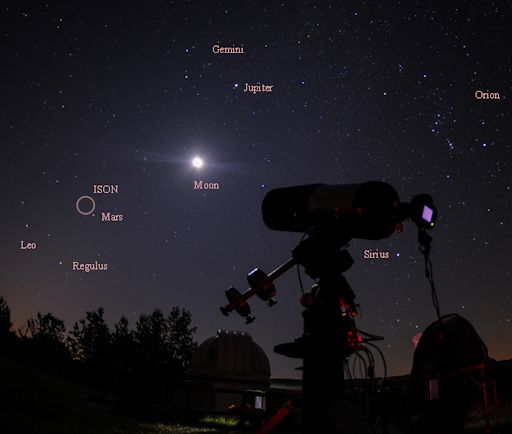When is the best time to see auroras? Where is the best place to go? And how do you photograph them? These questions and more are answered in a new book, Northern Lights - a Guide, by Pal Brekke & Fredrik Broms. | | |
CME IMPACT, GEOMAGNETIC STORM: As expected, a CME hit Earth's magnetic field during the early hours of October 2nd, sparking a G2-class geomagnetic storm. In North America, auroras spilled across the Canadian border into more than a dozen northern-tier US states. Jason Brownlee sends this picture from Bend, Oregon:

"It's not too often we get to see Northern Lights in Oregon," says Brownlee. "It made a special appearance last night in the Cascade Mountains. "
The storm has subsided now, but it could flare up again. NOAA forecasters estimate a 65% chance of more polar geomagnetic storms as Earth passes through the wake of the CME on Oct. 2-3. Aurora alerts: text, voice.
Realtime Aurora Photo Gallery
THE INSTIGATING CME: The CME that hit Earth's magnetic field today left the sun on Sept. 30th, propelled by an erupting magnetic filament. SOHO photographed the CME at the start of its journey, racing away from the sun at 2 million mph (900 km/s):

The CME was impressive, but the underlying explosion was even more so. One movie from NASA's Solar Dynamics Observatory shows the self-destructing filament in the context of the whole sun. Another movie zooms in for a closeup. It catches the filament ripping through the sun's atmosphere and leaving behind a beautiful "canyon of fire."
NOAA forecasters working through the government shutdown estimated an almost-even 45% chance of polar geomagnetic storms when the CME arrived. The CME justified those relatively high odds, sparking a G1-class geomagnetic storm around the poles. Geomagnetic storm alerts: text, voice.
Realtime Space Weather Photo Gallery
COMET ISON'S FLYBY OF MARS: In two months, Comet ISON will make a spectacular flyby of the sun. First, though, it has to fly by Mars. Today, the comet is passing by the Red Planet only 0.07 AU (10.5 million km) away. This is giving Mars satellites and rovers our first close-up view of the sungrazer: video.
Amateur astronomers on Earth are watching the close encounter from afar. This photo from Malcolm Park of Oak Heights, Ontario, shows the location of the comet relative to Mars just before sunrise on Sept. 29th:

At closest approach on Oct. 1-2, Mars and Comet ISON will be approximately 2o apart. While Mars is visible to the unaided eye (it shines almost as brightly as a first-magnitude star), ISON is not. The comet is still far from the sun and, as it crosses the orbit of Mars, it has not yet warmed enough to reach naked-eye visibility. Reports of the comet's brightness vary from 12th to 14th magnitude, which means a mid-sized backyard telescope is required to see it.
Mars and ISON rise together in the eastern sky a couple of hours before the sun. Amateur astronomers, if you have a GOTO telescope, enter these coordinates. Visually, Mars will be easy to find on the mornings of closest approach, not only because the planet is relatively bright, but also because the crescent Moon will be passing right by it. Sky maps: Oct. 1, 2.
New images of the comet are coming in every day. Browse the gallery for the latest views:
Realtime Comet ISON Photo Gallery
Realtime Noctilucent Cloud Photo Gallery
[previous years: 2003, 2004, 2005, 2006, 2007, 2008, 2009, 2011]

